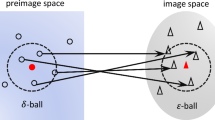Abstract
Some problems arising in identification of stochastic systems due to using nonlinear measures of dependence of random variables (processes) were analyzed. Recent publications describing approaches based on a consistent measure of dependence such as the mutual information were discussed. A constructive procedure of creating the linear input-output model that is statistically equivalent to the nonlinear dynamic stochastic system with white-noise Gaussian input process was proposed. The condition for coincidence of the mutual information of the input and output processes of the system and the mutual information of the input and output processes of the model which is used as a criterion for statistical linearization is pivotal to this procedure. This approach enables one to establish explicit relations defining the weight coefficients of the linearized model without using the unrealistic—in the context of identification—a priori condition for knowledge of the joint distribution of the output processes of system and model.
Similar content being viewed by others
REFERENCES
Sarmanov, O.V., Maximum Correlation Coefficient (Nonsymmetrical Case), Dokl.Akad.Nauk SSSR, 1958, vol. 121, no. 1, pp. 52–55.
Rényi, A., On Measures of Dependence, Acta Math.Hung., 1959, vol. 10, no. 3–4, pp. 441–451.
Dispersionnaya identifikatsiya (Dispersion-based Identification), Raibman, N.S., Ed., Moscow: Nauka, 1981.
Sarmanov, O.V. and Zakharov, E.K., Measures of Dependence between Random Variables and Spectra of Stochastic Kernels and Matrices, Mat.Sb., 1960, vol. 52(94), no. 4, pp. 953–990.
Stoorvogel, A.A. and van Schuppen, J.H., System Identification with Information Theoretic Criteria, in Identification, Adaptation, Learning, Bittanti, S. and Picci, G., Eds., Berlin: Springer, 1996, pp. 289–338.
Durgaryan, I.S. and Pashchenko, F.F., Plant Identification by the Criterion for Maximum of Information Content, Avtom.Telemekh., 2001, no. 7, pp. 91–102.
Prangishvili, I.V. et al., Determination and Modeling of Regularities from Experimental Data, in Sistemnye zakony i zakonomernosti v elektrodinamike, prirode i obshchestve (System Laws and Regularities in Electrodynamics, Nature, and Society), Moscow: Nauka, 2001, ch. 7, pp. 411–521.
Prangishvili, I.V. et al., Problem of System Modeling, in Sistemnye zakony i zakonomernosti v elektrodinamike, prirode i obshchestve (System Laws and Regularities in Electrodynamics, Nature, and Society), Moscow: Nauka, 2001, ch. 3, pp. 200–235.
Korolyuk, V.S. et al., Spravochnik po teorii veroyatnostei and matematicheskoi statistike (Handbook on Probability Theory and Mathematical Statistics), Moscow: Nauka, 1985.
Sarmanov, O.V., Pseudonormal Correlation and Its Various Generalizations, Dokl.Akad.Nauk SSSR, 1960, vol. 132, no. 2, pp. 299–302.
Author information
Authors and Affiliations
Rights and permissions
About this article
Cite this article
Chernyshev, K.R. Using Informational Measures of Dependence in Statistical Linearization. Automation and Remote Control 63, 1439–1447 (2002). https://doi.org/10.1023/A:1020082120927
Issue Date:
DOI: https://doi.org/10.1023/A:1020082120927




